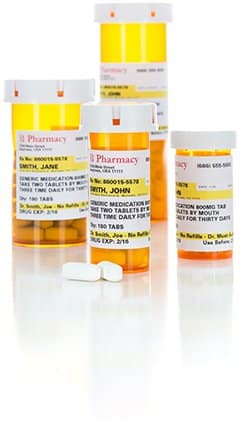Medical Option
The majority of patients with primary aldosteronism have the bilateral form of the disease, a subtype treated with medications called mineralocorticoid receptor antagonists (MRAs). Two drugs are currently available in this category: Spironolactone and Eplerenone.
MRAs are “potassium sparing diuretics.” Their most immediate impact is therefore on hypertension. They not only help patients eliminate the sodium they retain, unlike other diuretics like Hydrochlorothiazide, they do so without wasting potassium.
MRAs do not act on aldosterone itself. Instead, they inhibit its effects by blocking its receptors. The added cardiovascular, renal and metabolic benefits of MRAs are derived from this blocking role. This is not without a tradeoff: the blockade triggers a counterregulatory production of aldosterone, i.e. in most patients, MRAs further increase aldosterone levels. As a result, they are seldom effective at low dose, and patients can experience a great deal of difficulty in finding optimum dosage.
To be effective, medical treatment must also address renin levels. It is estimated that unless renin reaches 1 µg/L or higher, the deleterious effects of excess aldosterone persist despite the use of MRAs. While some patients may achieve this goal, others do not irrespective of medication dosage, restricted sodium intake, and potassium supplementation.
About Receptors
Hormones are biochemical messages that travel through the bloodstream and attach to cells which have receptors for that hormone. In a sense, the receptor acts as a lock, the hormone as the key. Once the hormone is attached to the receptor, it activates or triggers certain biological functions in the cell.
Aldosterone is the main mineralocorticoid hormone in the body, and is essential to ensure that sodium and potassium stay in balance.
The medications used to treat PA help to control the effect of aldosterone by attaching to the mineralocorticoid receptors.
Spironolactone
Spironolactone was introduced in 1959. It is the oldest and most widely prescribed MRA. It is available as a generic drug in most countries, and is also sold under brand names such as Aldactone, Spiractin, and Verospiron.
Spironolactone is a potent antihypertensive. When it is added to their regimen, most patients can reduce the number of antihypertensives they take, and some can control their blood pressure with Spironolactone alone. The typical starting dose is 12.5 mg/day which can be increased up to a maximum of 100 mg/day or even higher in some patients.
As with all medications, Spironolactone is not devoid of side effects. Spironolactone inhibits free testosterone from binding to androgen receptors in the cytoplasm of breast cells. This inhibition results in a shift in the balance towards estrogen-induced breast tissue proliferation.
As a result, up to 10% of men develop gynecomastia (enlargement of the breasts). Although incidence is unknown in women, they experience the same type of side-effects with menstrual irregularities, breast tenderness and/or enlargement. More importantly, Spironolactone carries a black-box warning for tumor risk as it has been found to cause tumor development in rats.
Eplerenone
Eplerenone was brought to market in the US in 2002 under the brand name Inspra. It has more affinity for mineralocorticoid receptors and less affinity for sex hormones receptors, and is usually better tolerated.
Eplerenone is not a potent antihypertensive, and it has a short half-life (i.e. half a dose is rapidly metabolized and eliminated from the bloodstream). Not only are higher doses necessary, the drug must be taken twice a day. The initial starting dose is 25 mg twice a day, and can be increased to 100 mg/day or even higher for some patients.
Although Eplerenone is available as a generic drug, it is more expensive than Spironolactone, and some US health plans may not approve its use unless Spironolactone has been tried first.
Other Antihypertensives

While calcium channel blockers (e.g. Nifedipine) are an effective option for some primary aldosteronism patients, others report limited antihypertensive effect with angiotensin-converting enzymes inhibitors (e.g. Lisinopril) and angiotensin receptor blockers (e.g. Losartan).
Since they belong to different classes, the above drugs only help to lower blood pressure. They do not provide any of the mineralocorticoid receptor blocking effects associated with MRAs.
Various factors can affect the supply of antihypertensive drugs. On its website, the US FDA maintains a list of drugs impacted by shortages and discontinuations.
Next Generation Therapeutics
Current medical options have considerable limitations starting with the fact that MRAs do not address excess aldosterone itself, and that being steroidal in nature, they are bound to have limited tolerability. While resolving the latter is becoming reality, the former remains elusive.
Esaxerenone, the first non-steroidal mineralocorticoid blocker, was approved in 2019 in Japan to treat essential hypertension. The drug is potent, has a long half-life, and acts on renal tubules and inhibits mineralocorticoid receptors in other tissues more strongly than MRAs. Its affinity is actually considered to be 4- and 76-fold higher than Spironolactone and Eplerenone respectively. The magnitude and sustainability of its blood pressure lowering effect are such that Esaxerenone can be used as monotherapy. Whether or when the drug will be brought to market outside of Japan is unknown.
Developed by German pharmaceutical company Bayer, Finerenone belongs to the same class, and is now available under the brand name Kerendia. However, unlike Esaxerenone, it has never undergone clinical trial to treat PA.
For over a decade, aldosterone synthase inhibitors (ASIs) have been seen as an alternative to MRAs to lower blood pressure and prevent the non-genomic effects of aldosterone. All attempts with first-generation compounds failed, mostly because they also caused decreased cortisol production (these earlier versions have since been repurposed for the treatment of Cushing’s disease). Next-generation ASIs are undergoing clinical trial, and are expected to become available in 2025-26.
Lack of PA-Specific Trials
MRAs were neither developed nor approved for use in primary aldosteronism.
Although off-label prescribing is entirely legal and very common, the practice is however less than ideal since it lacks the efficacy and safety studies customary before the widespread use of drugs.
Pharmacologic superiority of non-steroidal mineralocorticoid blockers has been demonstrated. Yet, clinical trials of Finerenone solely focused on conditions for which far more solutions are available than for primary aldosteronism.
If you or someone you know has long-standing and/or hard to control hypertension, we invite you to sign the Foundation’s Open Letter to help create the paradigm shift needed to advance standards of care for patients with PA.
References
- Funder, J. W., Carey, R. M., Mantero, F., Murad, M. H., Reincke, M., Shibata, H., Stowasser, M., & Young Jr, W. F. (2016). The management of primary aldosteronism: case detection, diagnosis, and treatment: an Endocrine Society clinical practice guideline. The Journal of Clinical Endocrinology & Metabolism, 101(5), 1889-1916.
- Young Jr, W. F. (2019). Diagnosis and treatment of primary aldosteronism: practical clinical perspectives. The Journal of Internal Medicine, 285(2), 126-148.
- Lechner, B., Lechner, K., Heinrich, D., Adolf, C., Holler, F., Schneider, H., Beuschlein, F., & Reincke, M. (2019). Therapy of endocrine disease: medical treatment of primary aldosteronism. European Journal of Endocrinology, 81(4), R147-R153.
- Ito, S., Itoh, H., Rakugi, H., Okuda, Y., Yoshimura, M., & Yamakawa, S. (2020). Double-blind randomized phase 3 study comparing esaxerenone (CS-3150) and eplerenone in patients with essential hypertension (ESAX-HTN Study). Hypertension, 75(1), 51-58.

